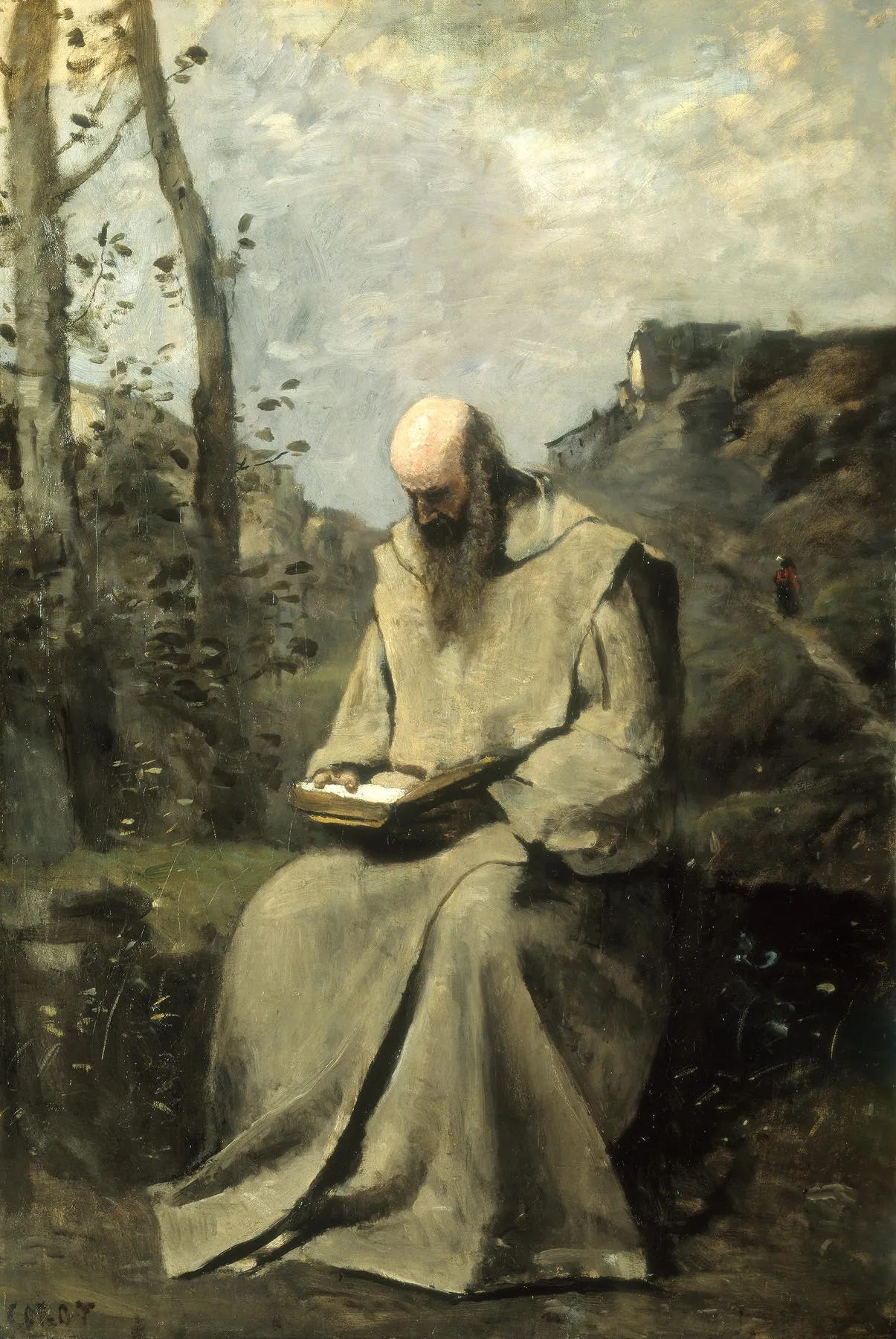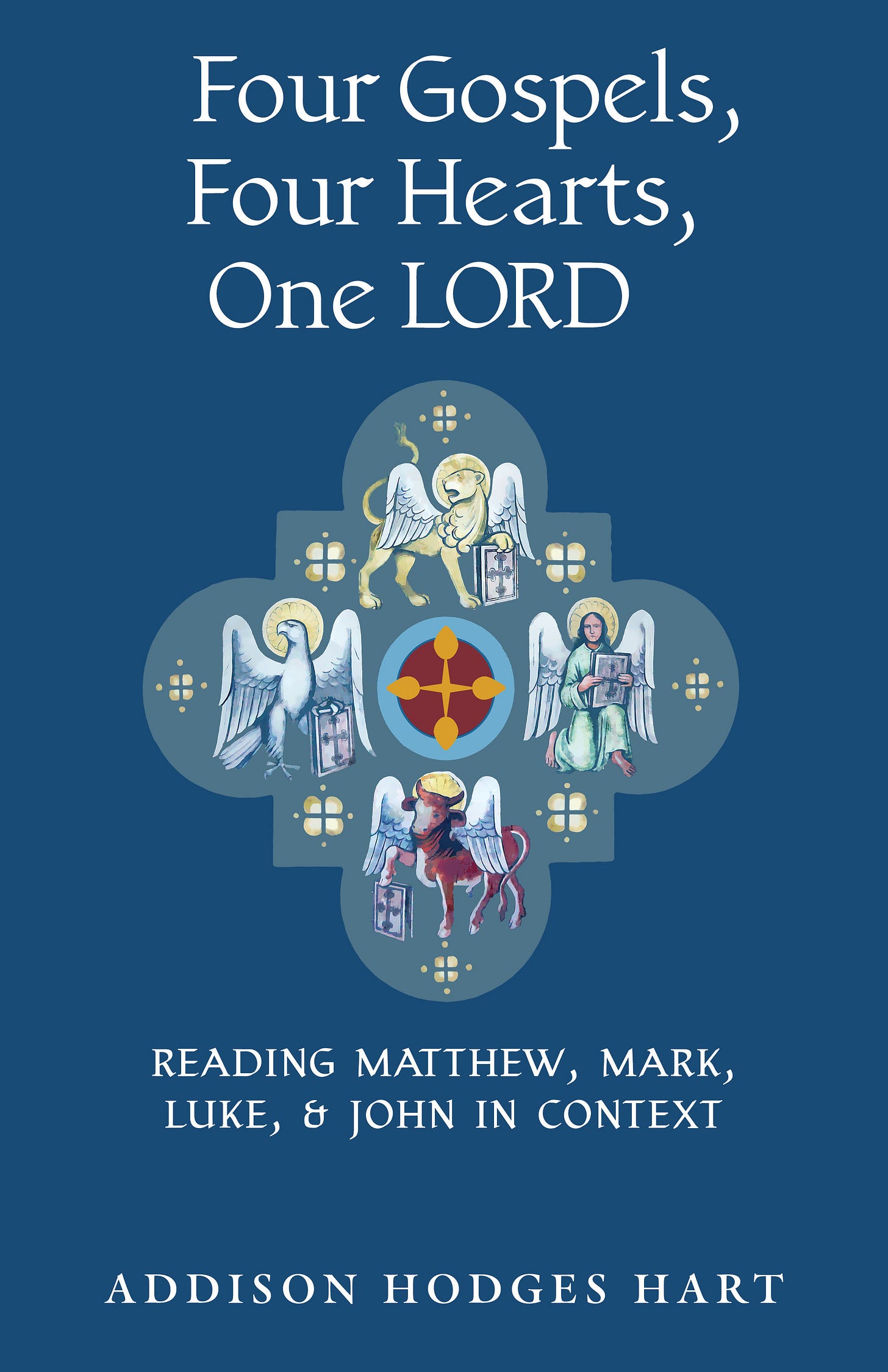Second of two excerpts from: "Four Gospels, Four Hearts, One Lord: Reading Matthew, Mark, Luke, and John in Context" (gratis post)
The right way to read scripture
This is the second of two gratis excerpts from my new book, to be released by Angelico Press on October 14th, and soon available from booksellers everywhere. When I return from retreat, I will resume my usual output of new Substack posts.
(Unknown monastic artist, 12th century, Kyiv Caves Monastery)
There is a right way to read the Bible in Christian tradition. It is sound, intelligent, “spiritual,” and it dates to the earliest centuries. I will be unequivocal on the point: what I outline below is the authentic practice — developed, schematized, and refined over time, certainly, but essentially, it’s the “way” of reading the sacred texts that would have been recognizable, until relatively recently, to Hebrews and Christians alike. For example, we find Paul (rabbi and apostle) employing a form of it in his letters whenever he “exegetes” passages from the Old Testament, and we should not fail to notice that he never once explains these texts as a modern interpreter would. For Paul, they are “spiritual” and, most often, allegorical. Now, I’m not saying that other ways of reading the Bible haven’t become customary in a variety of contexts over the past five hundred years; I am saying, though, that those other ways are not the right way — not right, at any rate, if one wants to understand what Origen (c. 185 – c. 253) meant when he likened the “eating” of scripture to partaking of the Eucharist, so that in turn (as Henri de Lubac explained) it might “unlock the divine secret hidden in our heart.” (quoted in Špidlík 1986). [1] I dare say, the traditional Christian method of reading the Bible among modern-day Christians is something of a lost art, and the consequences of that failure have been grim.
In the case of biblical fundamentalism, the damage inflicted has been long-lasting and grievously harmful. Those who have reacted against it, sometimes intemperately, have had just cause. In the Protestant world, the Bible has often been regarded as “the Word of God” without necessary qualification or caveat, read as a flat univocal text, and considered the only foundation for faith and practice. This ahistorical, untraditional, and illiterate way of reading the scriptures now appears to many — again, quite wrongly — to be the indisputable standard; both believers and unbelievers alike assume it to be so, which is why secular critics of the Bible usually come across like reverse-fundamentalists. Whenever one hears the unsurprisingly ignorant claim that the Bible — usually in reference to the Hebrew Bible or Old Testament, although the New Testament comes in for its fair share of lumps, too — is just a “Bronze Age” production with a particularly nasty deity at its center, the chief blame for that widespread impression falls squarely on the shoulders of biblical literalists.
My focus in what follows will be that mystical tradition of reading scripture which has deep patristic and monastic roots — monastic, because in the Middle Ages literacy was preserved and taught in the monasteries. At the heart of monastic ascetical practice was what came to be known in the Latin West as lectio divina, or “holy reading.” It was also the practice in the Greek and Syriac East, which was its cradle, but not schematized with the same precision as it was to become in the Latin context.
(Sitting Monk, Reading, painting by Jean-Baptiste Camille Corot, c. 1865)
Lectio divina was not confined to the reading of scripture. Other revered literature was also included in its purview. But primarily and most importantly, the books of the Old and New Testaments were “devoured” as spiritual food, and they nourished the “eater” with their life-giving nutrients for sustaining mystical life. Lectio divina was, without question, at the very heart of spiritual practice. For any reading these words who might have been battered by fundamentalism’s abusive use of the Bible in the past, this may seem inconceivable. But earlier Christians, whatever other deficiencies they may have had in their particular times and places, weren’t literalists, and the ugly, debased fundamentalism we find so prevalent in our own society happily was unknown to them. The Bible was integral to spiritual tradition and could only be appreciated rightly within the context of liturgical and mystical prayer. Indeed, there were some portions of the Bible that were deemed unedifying, even for monks, and were considered too morally problematic to be for general consumption (as I said, these were not fundamentalists; they had a keen sense of moral propriety). This sensitivity in discriminating between what was useful and beneficial in the scriptures and what was not dates to the earliest centuries of Christianity. The Bible was not considered to be a “flat” or univocal book, and not everything in that vast collection of texts was thought to be profitable spiritually.
This basic, rather obvious, and thoroughly honest insight might be the first thing we could recover to our benefit. The Bible is not simply a “good book”; it’s a complicated library of books, not without ambiguity, and it can’t be reduced to any single neat system of ideas. That may frustrate those who believe in that exotic mythical beast called “biblical theology” (as if anything so consistent or concrete could emerge from that literary convergence of differing perspectives and genres, all of them in flux and affected by numerous outside cultural influences over the course of ages), but — perhaps paradoxically — it’s also why so much of it is conducive to engendering profound spirituality when read rightly.
So, then, how do we read it rightly?
To begin with, we will consider the “senses” of scripture, of which there are two, the second comprising three “sub-senses.” As I’ve already noted, the idea that there can be layered “senses” in the texts we read was commonplace in antiquity. Some written texts, of course, have no depth, no “layers” of meaning. Take a grocery list as an example. It is what it is, the instructions for assembling your latest IKEA purchase are as literal as any text can possibly be, and so on. Other texts, however, whether poetry or prose or drama (the ancients loved plays), could be and, in fact, most often should be read on multiple levels. The two most obvious levels are the literal level and the metaphorical or representational level. Ancient readers of Homer, for example, read The Iliad and The Odyssey both as “ripping yarns” of mythological history and as spiritually enlightening texts. This two-level reading of many texts has always been part of literature (and drama, cinema, and television, as well). We take it for granted, whether we are conscious of it or not. The problem with literalism, of course, is that it doesn’t go further than the first level. That would be fine if the text is a grocery list, say, or a tourist guide, or the IKEA instruction booklet I mentioned. But spiritual texts, or texts that are at least read for spiritual purposes, like serious literature of all kinds, cannot be read simply on that level. The literal level is the primary one, of course, but there are deeper levels to be plumbed.
It’s important to understand what literal meant in the ancient world and, in fact, still means today. There’s some confusion about its meaning among fundamentalists, who assume that a poetic (and rather late) text such as the first chapter of Genesis, which uses parallelism masterfully to describe the essentially indescribable appearance of all things, is literally true. That the text has meaning has never been in dispute; but it’s never been understood, even by its ancient readers, as a simple description of “what really happened.” Any claim that the Bible contains science as we know it or the sort of historiography that we are used to, which is only a few centuries old, is an illiterate claim. However, the literal sense is basic to reading, even to “spiritual reading.” What literal means is simply this: what the text actually says on the surface level. It has nothing to do with whether the thing, event, or person described in a given text is fact or fiction. The literal reading of this passage from Tarzan of the Apes by Edgar Rice Burroughs is plain enough: “As the body rolled to the ground Tarzan of the Apes placed his foot upon the neck of his lifelong enemy and, raising his eyes to the full moon, threw back his fierce young head and voiced the wild and terrible cry of his people.” That’s very, very literal. It’s also utterly fictional (and not at all metaphorical). Reading that sentence literally, we don’t need to believe in its veracity.
(Boris Kustodiev, “Abbess,” 1901)
The clearest statement about reading the scriptures according to the two senses (and three sub-senses) is found in the fourteenth conference of John Cassian’s Conferences. Cassian (c. 360 – c. 435) and his companion, Germanus, are being instructed by the desert monk, Abba Nesteros, “a man of the highest knowledge and outstanding in every regard.” [2] He is teaching them about “contemplating the secrets of invisible mysteries,” and he says that, in order for that to happen, they must learn to practice “a defined order and method.” He makes a twofold distinction, between theoretike (“which consists in the contemplation of divine things and in the understanding of most sacred meanings”) and praktike (i.e., what can be “practiced,” “practical”: “which reaches its fulfillment in correction of behavior and in cleansing from vice”): “Whoever, therefore, wishes to attain to the theoretike must first pursue practical knowledge with all his strength and power. For the praktike can be possessed without the theoretical [i.e., contemplation], but the theoretical can never be seized without the practical.” In other words, the moral life is integral to the full experience of contemplation. It is in relation to this subject of the practical and the theoretical (or contemplative) that Abba Nesteros teaches them about the senses of spiritual reading — and, in fact, uses Paul’s treatment of the Old Testament (in Galatians 4 and 1 Corinthians 10, specifically) as a model.
The literal sense, then, is the place for exegesis: what we can unpack “out of” the text — what it is telling us on the surface. Whether it’s history, legend, parable, poetry, prophecy, etc., we are only concerned with the details (including words, context, cultural and historical background, and so on) of the text. At this stage, help from commentaries, the notes in a (good) study Bible, lexicons, and so on may come in handy. But a word of caution: lectio divina should not become a formal study. Study is fine in its place, even to be encouraged, but lectio proper must stay mentally contemplative and therefore more concerned with the spiritual senses.
Besides the literal reading, there are “three kinds of spiritual knowledge” — the “sub-senses” I mentioned. In other words, what I have been calling the “metaphorical” level of reading, Abba Nesteros calls the spiritual level, and he breaks this category into three sorts: the allegorical, the tropological (or moral), and the anagogical. [3]
The allegorical is the level at which “the things that the historical [literal] narrative conceals are laid bare by a spiritual understanding and explanation.” [4] The allegorical sense takes us from the level of “what’s explicitly on the page” to what the text signifies. For example, the Song of Solomon is literally a collection of erotic poems that may or may not have originally been written with allegorical intent; either way, it can be read simply as love poetry. The rabbis included it in the Hebrew canon because they saw in it an allegory of God’s love for the people of Israel. Origen and other early Christian exegetes transferred this essentially Judaic perspective to Christ and his “bride,” the church; and — more personally still — they applied the analogy to Christ and the individual soul (a “mystical” interpretation that continued throughout the patristic, medieval, and later ages). Images of battle in the Psalms and elsewhere were routinely interpreted as the interior struggle with our passions, thoughts, and the powers of evil (and some of us continue unapologetically to pray the rougher Psalms in precisely this way). The parables of Jesus — though some quibble about the term — are allegorical (and many of the Gospel stories about Jesus certainly have allegorical connotations). Paul’s treatment of the Hebrew Bible, as we noted, is almost exclusively allegorical.
The tropological or moral level is that at which “we discern by a prudent examination everything that pertains to practical discretion, in order to see whether it is useful and good.” [5] This sense is where we ponder how we are to live our lives, in the light of what we read. Jesus incisively addressed the state of our “heart” — that “from within” ourselves come the motivations of evil actions. Jesus, incidentally, was no easy comforter in that regard; he accepted his followers “as they were,” but with the proviso that their lives would henceforth mean the continuous transformation of their hearts inwardly and behavior outwardly. The idea of an all-inclusive Jesus — meaning “everything is permitted” by him — has no basis in the Gospels. He certainly invites us to follow him, but the stipulation is that we do what we are obliged to do if we intend to be made whole. One shouldn’t read the Gospels and overlook that central aspect.
The anagogical level is that at which the words of scripture “are directed to the invisible and to what lies in the future” — that is to say, to our “end” or ultimate aim (what Abba Moses, in Cassian’s very first conference, called our telos, – contrasting it with our immediate aim — skopos — which is to become self-disciplined). The anagogical has to do with the hope that accompanies the other two spiritual senses — that we are in a process, “mirroring the Lord’s glory ... being transformed into the same image, from glory to glory, as by the Lord, the Spirit” (2 Cor. 3:18, DBHNT). We are put in mind of “resurrection,” “eternal life,” “the age to come,” “the fullness of time,” “when that which is perfect has come,” “when God is all in all,” and, of course, “the judgment” — remembering that all these phrases and images are metaphors for what is inconceivable to us on this side of things. Lectio divina finds its fullest significance where the anagogical is concerned.
So, at the heart of devotional practice, we have this layered reading of sacred texts; ruminating on them, chewing them, devouring them, we assimilate their transformative nutrients. Again, not every text of scripture is conducive to this process, nor does every text carry all four levels of meaning. Some texts of the Bible, as Origen and others were forthright in acknowledging, are morally problematic and can’t easily be used for spiritual nourishment.
No spiritual “method” works mechanically. That should be said before moving on to a more detailed discussion of the method of lectio divina. Christian “sacred reading,” as defined within the Tradition, is when God is perceived as present and communing with the “heart” (or mind) through the text. It requires of us a prepared state of inner receptivity. Another name for this inner state is “recollection” or, more aptly, re-collection. One re-collects one’s scattered thoughts and, in interior silence, gives undivided attention to the sacred page. In heightened experiences of this practice, the Spirit (or “Breath”) of God is felt to be — as “in the beginning” of all things — creatively brooding over the chaotic deep within the depths of the reader. (The New Testament uses graphic language about our inner depths, by the way: σπλάγχνα — “splagchna” — and κοιλία—“koilia” — refer to the guts or intestines in the first instance, and to the belly and the womb in the second; all that we mean by the “unconscious,” — including the dark, untamed, disturbingly irrational aspects of our hidden selves — can be associated with such imagery without too much conceptual strain.)
The sole purpose of this sort of attentive, spiritually alert concentration is, as we’ve said, communion with God. It isn’t “Bible study”; it isn’t done — if one is ordained — for the sake of preparing a homily; it isn’t done to gain an objectively “correct” understanding of a given text. It isn’t, in other words, an intellectual undertaking or for the accrual of “Bible knowledge.” It is subjective in the purest sense; one is preparing to be acted upon, not to act. One prepares oneself simply to receive and to listen. And “to listen” in the biblical/patristic/monastic vocabulary has as its aim a co-operation—“synergy”—with the action of the Spirit (“work out your own salvation in reverence and trembling, for it is God who is making active within you both the willing and the working of that which is dearly desirable”; Philippians 2:12c 13, DBHNT). That’s the state of mind necessary for practicing lectio divina.
The effectiveness of the method, then, depends a great deal on our inner preparedness before we engage in it each day. There should be nothing hasty about the practice; we should give it all the time it takes. For it truly to assist in our “transformation by the renewal of our intellect” (see Rom. 12:3), it ought to become part of our regular routine—our personal “rule (regula) of life.” We will realize its mounting influence in our lives over time. In the words of Peter of Damascus (twelfth century), “We who do no more than listen to the Scriptures, should devote ourselves to them and meditate on them so constantly that through our persistence a longing for God is impressed upon our hearts, as St Maximos [the Confessor] says.” [6] As with any serious discipline, then, its value can only be ascertained over the long haul.
When it comes to the actual practice of lectio divina, one of the clearest texts on the subject is the work of the great Carthusian, Guigo II “the Angelic” (d. 1188), the ninth prior of Grand Chartreuse. [7] His short text, The Ladder of Monks, addressed to a brother named Gervase, lists four steps in the practice of lectio divina: lectio (reading), meditatio (meditation—which will need some clarification), oratio (prayer), and contemplatio (contemplation). [8] It’s an engaging text, written with warmth and charm—not uncommon during this golden period of healthy, flourishing, and humane Western monasticism. He introduces the subject in this inviting way:
One day when I was busy working with my hands I began to think about our spiritual work, and all at once four stages in spiritual exercise came into my mind: reading, meditation, prayer and contemplation. These make a ladder for monks by which they are lifted up from earth to heaven. It has few rungs, yet its length is immense and wonderful, for its lower end rests upon the earth, but its top pierces the clouds and touches heavenly secrets…
Reading is the careful study of the Scriptures, concentrating all one’s powers on it. Meditation is the busy application of the mind to seek with the help of one’s own reason for knowledge of hidden truth. Prayer is the heart’s devoted turning to God to drive away evil and obtain what is good. Contemplation is when the mind is in some sort lifted up to God and held above itself, so that it tastes the joys of everlasting sweetness. [9]
“Meditation” in this instance refers to a process of rational thought. It means “to ponder” or “consider.” Guigo compares it in his letter to chewing: masticatio or “mastication” (an analogy dating back to Origen and even further back to the sScriptures: see Eze. 3:1; Rev. 10:10). William of St. Thierry (first a Benedictine and later a Cistercian), another earlier contemporary of Guigo, referred to it as ruminatio—like a cow chomping on her cud, swallowing it, and bringing it back up for more chewing: “Some part of your daily reading should also each day be committed to memory, taken in as it were into the stomach, to be more carefully digested and brought up again for frequent rumination; something ... helpful to concentration, something that will take hold of the mind and save it from distraction.” [10] Since reading was usually performed out loud in ancient and medieval times, and muttered to oneself when in private (not a bad practice to have even today), the thought of the “mouth” chewing on a text came quite naturally to these writers. Guigo, then, continues with the analogy of “eating” the text as he describes the four “steps” of lectio:
Reading, as it were, puts food whole into the mouth, meditation chews it and breaks it up, prayer extracts its flavor, contemplation is the sweetness itself which gladdens and refreshes. Reading works on the outside, meditation on the pith; prayer asks for what we long for, contemplation gives us delight in the sweetness which we have found. [11]
He then provides an example of how these four aspects apply to a particular scripture. He takes the single line, “Blessed are the pure in heart, for they shall see God” (Matt. 5:8), and then walks us through the process. “This is a short text of Scripture,” he explains, “but it is of great sweetness, like a grape that is put into the mouth filled with many senses to feed the soul.” During the practice, Guigo pictures the reader pausing, “wishing to have a fuller understanding of this [text],” and beginning “to bite and chew upon this grape, as though putting it in a wine press, while it [the mind] stirs up its powers of reasoning...” This becomes, then, the act of meditation, no longer remaining “on the outside.” One’s mind is “not detained by unimportant things, climbs higher, goes to the heart of the matter, examines each point carefully.” He describes the many insights one might gain through meditation, but then adds a word of caution. One is not to stop here; this isn’t the end of the process.
Do you see how much juice has come from one little grape, how great a fire has been kindled from a spark, how this small piece of metal, “Blessed are the pure in heart, for they shall see God,” has acquired a new dimension by being hammered out on the anvil of meditation? And even more might be drawn from it at the hands of someone truly expert. I feel that “the well is deep,” but I am still an ignorant beginner, and it is only with difficulty that I have found something in which to draw up these few drops....
…[F]rom this [the soul] deduces how sweet it would be to know by experience the purity that meditation has shown to be so full of joy.But what is it to do? It is consumed with longing, yet it can find no means of its own to have what it longs for; and the more it searches the more it thirsts. As long as it is meditating, so long is it suffering, because it does not feel that sweetness which, as meditation shows, belongs to purity of heart, but which it does not give. [12]
In other words, the rational process will leave one high and dry—unfulfilled and still empty—unless it motivates the reader to go on to the other two stages. “So the soul,” Guigo writes, “seeing that it cannot attain by itself to that sweetness of knowing and feeling for which it longs … humbles itself and betakes itself to prayer…” [13] Through prayer (the third stage), the reader stills himself, assumes a posture of attentiveness and concentration, perhaps using a repeated word or phrase to subdue and restrain straying thoughts, and in that silent act of longing and expectation, awaits the grace of contemplation. “[God] slakes [the soul’s] thirst, He feeds its hunger, He makes the soul forget all earthly things: by making it die to itself He gives it new life in a wonderful way, and by making it drunk He brings it back to its true senses.” [14] In the contemplative state, Guigo tells the reader he may experience the gift of tears: “an outward washing proceeds from the inner cleansing … our inward stains are cleansed, by which the fires of our sins are put out.” [15] Other interior stirrings may occur as the divine presence makes itself evident, to which he can put no descriptive words:
Why do we try to express in everyday language affections that no language can describe? Those who have not known such things do not understand them, for they could learn more clearly of them only from the book of experience where God’s grace itself is the teacher. Otherwise it is of no use for the reader to search in earthly books: there is little sweetness in the study of the literal sense, unless there be a commentary, which is found in the heart, to reveal the inward sense. [16]
This last statement is a bold one and true. To understand something of what goes on within an individual engaged in the act of contemplation, one must practice contemplation oneself. “Only the book of experience” will do. Guigo is clear that the literal sense of scripture, all by itself, has limited, if any real value (and, as we know, it can also do positive harm). Lectio divina is deep reading. It takes time, and it requires effort, meditative “mastication,” prayer, moral and mental discipline, and silent contemplation. Its benefits to the soul, however, are beyond measure.
[1] Tomáš Špidlík, SJ, The Spirituality of the Christian East: A Systematic Handbook, trans. Anthony P. Gythiel (Kalamazoo, 1986), 5.
[2] John Cassian, The Conferences, trans. and annotated by Boniface Ramsey, O.P. (Mahwah, 1997), 505.
[3] Ibid., 509.
[4] Ibid., 510.
[5] Ibid., 511.
[6] Nikodemos of the Holy Mountain and Makarios of Corinth, comp., The Philokalia: The Complete Text, trans. from the Greek and ed. G. E. H. Palmer, Philip Sherrard, and Kallistos Ware, vol. 3, 123.
[7] He is called “Guigo II” to distinguish him from Guigo I, the fifth prior, and Guigo de Ponte, who lived a century later. Those who have seen the film Into Great Silence— – German title, Die große Stille— – will, no doubt, recall the majestic monastery of Grand Chartreuse and its surroundings.
[8] Another medieval writer, Hugo of St. Victor, an older contemporary of Guigo and an Augustinian canon, added a fifth step between oratio and contemplatio: operatio, or the doing of good works. Quite rightly, he saw that contemplative practice cannot be divorced from charitable action and “the works of mercy.”
[9] Guigo II, The Ladder of Monks: A Letter on the Contemplative Life and Twelve Meditations, trans. and intro. Edmund Colledge, O.S.A. and James Walsh, S.J. (London: /Oxford, 1978), 81 - 82.
[10] Theodore Berkeley, OCSO, trans., The Golden Epistle: A Letter to the Brethren of Mont Dieu, vol. 4, The Works of William of St Thierry, intro. J. M. Déchanet, OSB (Kalamazoo, 1980), 52.
[11] Guigo, Ladder of Monks, 82 83.
[12] Ibid., 85. Emphasis added.
[13] Ibid., 86.
[14] Ibid., 87. Emphasis added.
[15] Ibid., 88.
[16] Ibid., 89. Emphasis added.







I’m really looking forward to reading your book when it comes out, Addison, especially in light of the last two posts you dropped here. This one in particular is so important for those struggling with this library called “The Bible.” Whenever I hear a friend say that he’s going to start “reading the Bible,” he usually means he’s going to approach it like any other book. Open the first page and start reading, “In the beginning….” I feel my heart sink a little because I know they’ll probably get bogged down in the first set of geneologies, and if they make it that far I can only imagine what conclusions they’d draw after reading the mind-bending narratives they have encountered—talking serpents, magical, knowledge-giving fruits, a council of the gods. Presumably they open the Bible to encounter God, to find meaning and purpose in their lives. I think most honest searchers would out the book down and try somewhere else, like the fundamentalist church on the corner. Your council—citing the tradition—is the way forward. But I’m also of the belief that fewer and fewer people read much of anything nowadays making it inevitable that any kind of layered reading becomes more and more impossible. I know that sounds quite pessimistic, more than I ought to be. I will be passing on your book to a few people I know who might at least read an instructional manual and guide to reading the Bible.
This is a great treasure to me. It is as if one word carries the potential to answer a thousand questions. Thank you!